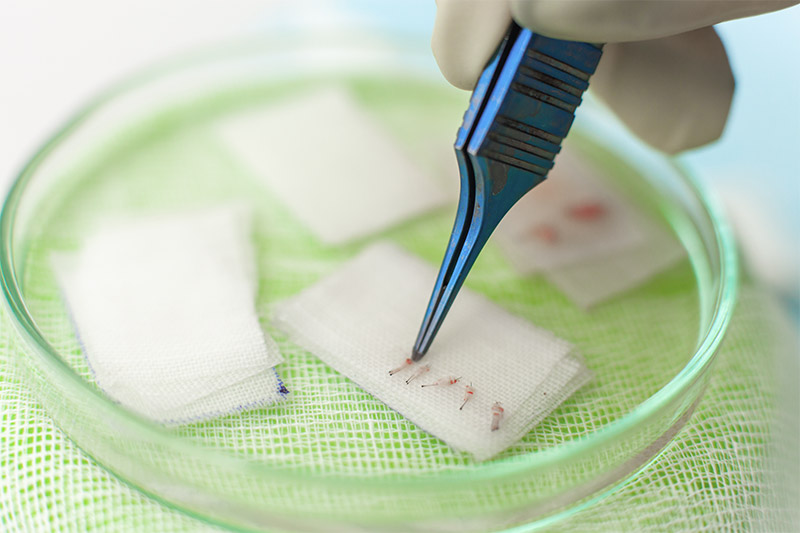These days there is a range of different surgical and non-surgical procedures offered for hair restoration. Today we're going to look at how surgical hair transplant works, particularly the FUE hair transplantation technique.
What is FUE hair transplant surgery?
Follicular unit extraction (FUE) is a no-scalpel, no-suture procedure that transplants hair follicles to the thinning areas of the scalp to increase the hair density under local anaesthesia. It is suitable for both men and women who are experiencing hair loss.
How does an FUE hair transplant work?
Here is a step-by-step process of the procedure:
- The donor area is prepared by shaving the region to keep the hairs 2-3mm long.
- Hair follicles are removed one by one from the donor area of the hair using special instruments. The most important is a hand-held punch that rotates, oscillates, and has an adjustable depth, allowing the hair transplant surgeon to set exact extraction parameters to suit the follicles and the scalp. This minimises the possibility of any injury to the healthy follicle.
- The donor area is usually the back of the head, where the hair is not affected by or susceptible to genetic hair loss. The hair transplant surgeon weighs the number of hairs needed and the density of follicles in the donor area against each other when deciding how many follicles should be extracted. This is to prevent over-harvesting from the donor area.
- The follicles are then prepared for implantation. They are dissected into groups of 1, 2, 3, or 4 hairs, sorted into size, and placed in an active plasma solution that ensures the health of the extracted hair follicle.
- The extracted hair follicles are now strategically placed into the thinning area of hair on the scalp. The implantation is done very carefully to match the direction of the curl of your existing hair to restore a natural-looking hairline.
What happens after FUE?
At-home aftercare for a hair transplant is not complicated, but it is important to give special attention to your newly repositioned hair to ensure they thrive and are not damaged. Our clinic gives detailed written and in-person instructions to ensure confidence with how to care for the transplant. And we're always a phone call away for any questions or concerns along the way.
During the initial few days after the procedure, the scalp will scab and become itchy. Try not to scratch, wear a hat or touch the grafts in a way that could dislodge them. The scabs will fall off by themselves. Don't wash the area for at least a week. After the first 7 days, you can wash the recipient area as you normally would.
During the first two weeks, avoid strenuous exercise, lifting weights, or swimming, and do not brush your hair or expose the new grafts to direct sunlight - so as not to risk dislodging the grafts.
It is normal after several weeks for the transplanted hair to fall out. This doesn't mean the transplant has failed, rather than the growth cycle is beginning again. The follicle is undamaged, the new hair is preparing to sprout.
Learn more about the phases of hair growth here.
Learn more about the hair transplantation timeline here.
Advantages of a Follicular Unit Extraction
There are many advantages to this form of hair transplantation, for example:
- The procedure does not require you to take any heavy pain-relieving medication post-procedure as they are not necessary.
- The recovery time post-procedure is limited, and you can return to work or responsibilities the following day.
- There are no stitches or staples to be removed from your head that may cause scarring as the procedure does not involve long incisions and is therefore significantly less surgically invasive.
- If you have limited hair on the back and sides of your scalp (the traditional donor area), hair follicles can be extracted from elsewhere on your body instead.
- The result of the procedure is natural, and the hair growth looks authentic. The doll's hair or hair plugs appearance of 30-40 years ago do not occur with today's modern procedures and instruments.
Key takeaways
- Follicular unit transplantation extracts hair one-by-one from the donor area at the back of the scalp, then implants them into the balding areas of the scalp to restore the hairline.
- After the procedure, patients will need to take special care of the repositioned hair to ensure there is no damage done to the follicles.
- Several weeks after the procedure the transplanted hair will fall out. This is not a failure, just the hair follicle beginning its new hair regrowth cycle.
- Our team at Paras Hair Transplant are dedicated to helping you achieve your goals for hair restoration and maximise your hair. Find out if you are suitable for a hair transplant today by getting in contact.







